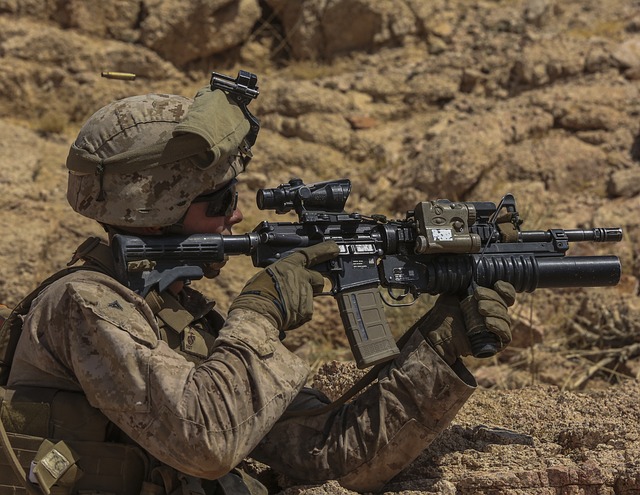The 82nd Airborne Division Flag, a powerful symbol of American military history, holds immense historical value and has been displayed in army museums globally. This iconic artifact narrates stories of bravery and sacrifice by one of America's most decorated units, notably earning its nickname "Screaming Eagles" in World War II. Museum displays of the flag inspire visitors with tales of resilience, unity, and freedom, preserving military heritage and honoring past soldiers. Conservation efforts ensure the flag's physical integrity and symbolic value for future generations.
“The 82nd Airborne Division Flag, a powerful symbol of military history, takes center stage in army museums worldwide. This article delves into the historical significance of this iconic flag, exploring its place in exhibits and its role in preserving the memories of the brave soldiers who carried it. From traditional displays to personal narratives shared by veterans, each museum offers a unique perspective. Additionally, we uncover the meticulous care and conservation efforts ensuring these historic flags remain intact for future generations.”
- Historical Significance of the 82nd Airborne Division Flag
- Displaying the Flag in Army Museums: A Tradition and Purpose
- The Role of Veterans and Their Stories in Museum Exhibits
- Preserving History: Care and Conservation of Museum Flags
Historical Significance of the 82nd Airborne Division Flag

The 82nd Airborne Division Flag holds immense historical significance, representing the valor and sacrifices of one of America’s most decorated military units. This iconic symbol has been a staple in army museums and exhibits worldwide, telling tales of bravery and determination on foreign soil. The flag, with its distinctive design and colors, serves as a powerful reminder of the division’s pivotal roles in numerous historical campaigns, including World War II, where it earned the nickname “Screaming Eagles” for their daring airborne assaults.
In these museums, visitors can witness firsthand the flag’s journey, from its initial raising on foreign soil to its return home, bearing witness to the battles won and lives lost. The 82nd Airborne Division Flag stands as a symbol of resilience, unity, and freedom, inspiring current and future generations to uphold the values it represents—values that continue to shape military strategies and tactics even in today’s modern warfare landscape.
Displaying the Flag in Army Museums: A Tradition and Purpose

In army museums, the display of ceremonial flags holds a significant place, symbolizing the history and valor of military units. The 82nd Airborne Division Flag, for instance, is not just a piece of cloth but a living testament to the division’s bravery, sacrifice, and strategic significance. It serves as a central attraction in exhibits designed to educate visitors about the unit’s achievements, from pivotal battles to modern-day operations.
The tradition of showcasing such flags stems from their profound purpose: to pay homage to past and present soldiers, inspire pride, and preserve the memory of crucial missions. Each fold and stitch tells a story—of comradeship, resilience, and the unyielding spirit that defines military service. Museum visitors can gain a deeper understanding of the 82nd Airborne Division’s role in various conflicts by observing these flags, fostering a sense of connection to history and honor for those who served.
The Role of Veterans and Their Stories in Museum Exhibits

The stories of veterans and their experiences are integral to the exhibits in army museums, adding depth and historical context to the displayed artifacts. These narratives humanize military history, allowing visitors to connect with the past on a personal level. For instance, an exhibit featuring the 82nd Airborne Division Flag can be accompanied by the account of a veteran who carried this very flag during a pivotal battle, detailing their bravery and the significance of the moment. Such personal stories bring historical events to life, fostering empathy and understanding among museum-goers.
Museums provide a space for veterans to share their journeys, ensuring that their sacrifices and experiences are remembered. By integrating these accounts into exhibits, museums pay tribute to the men and women who served, allowing visitors to grasp the complexities of military service and the individual stories that contribute to larger historical narratives.
Preserving History: Care and Conservation of Museum Flags

In army museums and exhibits, the care and conservation of historical flags play a pivotal role in preserving the rich tapestry of military history. Each flag, like the esteemed 82nd Airborne Division Flag, carries profound significance, representing the valor, sacrifice, and resilience of the units it represents. The process of preservation involves meticulous cleaning, repair, and storage methods to safeguard these fragile artifacts from environmental damage and decay.
Museum professionals employ specialized techniques tailored to each flag’s unique material and construction. For instance, proper handling and conservation of textiles ensure that flags like the 82nd Airborne Division Flag remain in pristine condition for future generations. These efforts not only maintain the physical integrity of the flags but also preserve the stories and memories they embody, allowing visitors to appreciate and understand the profound impact of military history.
The 82nd Airborne Division Flag, a symbol of courage and resilience, holds historical significance that is rightfully celebrated in army museums worldwide. These institutions serve as custodians of our military heritage, preserving the flag through meticulous care and conservation, while also weaving personal narratives from veterans into their exhibits. By displaying the 82nd Airborne Division Flag, museums not only honor the past but also inspire future generations, ensuring that stories of bravery and sacrifice are never forgotten.
